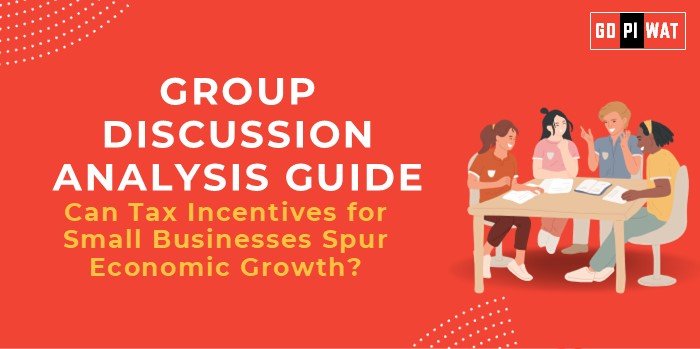📋 Group Discussion Analysis Guide
🌐 Topic: Can Tax Incentives for Small Businesses Spur Economic Growth?
💡 Introduction to Tax Incentives for Small Businesses
“Small businesses form the backbone of most economies, contributing significantly to employment and GDP. Tax incentives are often proposed as a means to support these businesses, enabling growth, innovation, and economic expansion.”
Globally, small businesses contribute over 40% to GDP and employ more than 50% of the workforce. Governments frequently use tax incentives, such as deductions, credits, and exemptions, to stimulate small business growth. The effectiveness of these policies, however, remains a topic of debate.
📊 Quick Facts and Key Statistics
- Economic Contribution: Small businesses contribute 40%+ to global GDP (World Bank, 2023).
- Employment Impact: SMEs employ 70% of the global workforce (ILO, 2023).
- Tax Incentives Examples:
- U.S. Tax Cuts and Jobs Act (2017) reduced SME tax rates to 21%, boosting investments by 12%.
- India’s 2023 budget increased MSME loan guarantee funds by ₹9,000 crore, spurring credit access.
- Impact on Innovation: SMEs account for 30% of global patents, often driven by tax benefits (OECD, 2022).
🧩 Stakeholders and Their Roles
- Governments: Design effective tax policies to incentivize investment, innovation, and job creation.
- Small Businesses: Leverage tax incentives for growth, infrastructure development, and R&D.
- Banks/Financial Institutions: Offer complementary credit facilities, leveraging tax benefits as risk mitigators.
- Consumers: Indirectly benefit from improved services, job opportunities, and economic growth.
🏆 Achievements and Challenges
Achievements
- Increased Investments: Tax incentives in the UK led to a 20% rise in SME investments between 2015 and 2020.
- Job Creation: U.S. small business tax breaks contributed to creating 1.6 million jobs (2018–2020).
- Encouraging Innovation: R&D tax credits have spurred innovation in SMEs, particularly in tech sectors.
Challenges
- Revenue Loss for Governments: Tax incentives can strain public finances, reducing funds for infrastructure and welfare.
- Unequal Access: Larger firms often exploit loopholes, sidelining genuine small businesses.
- Global Comparisons: While tax incentives worked in Germany, similar efforts in Brazil led to tax evasion and limited growth.
📚 Structured Arguments for Discussion
- Supporting Stance: “Tax incentives empower small businesses by freeing up resources for expansion, leading to job creation and economic growth.”
- Opposing Stance: “Tax incentives often result in revenue losses and are exploited by larger entities, diluting their intended impact on small businesses.”
- Balanced Perspective: “While tax incentives can stimulate growth, their effectiveness hinges on proper targeting, robust implementation, and anti-abuse mechanisms.”
✍️ Effective Discussion Approaches
- Opening Approaches:
- Statistical Highlight: “With SMEs contributing 70% of global employment, tax incentives could serve as a crucial lever for sustained economic growth.”
- Global Comparison: “Germany’s SME-focused tax credits boosted productivity by 15% in a decade, illustrating the transformative potential of such incentives.”
- Counter-Argument Handling:
- Counterpoint: “Revenue losses from tax incentives can be mitigated by tying them to performance metrics like job creation or R&D spending.”
- Data-backed Rebuttal: “In the U.S., targeted tax policies for SMEs yielded a $300 billion GDP boost within five years.”
📈 Strategic Analysis of Strengths and Weaknesses
- Strengths: Enhances business competitiveness, encourages innovation, and creates jobs.
- Weaknesses: Potential for abuse, revenue loss, and implementation challenges.
- Opportunities: Develop targeted incentives for green technologies, women-owned enterprises, and rural businesses.
- Threats: Misuse by large firms, global tax competition, and policy inefficiencies.
🎓 Connecting with B-School Applications
- Real-World Applications: B-school projects on fiscal policy, entrepreneurship, and impact assessment of tax incentives.
- Sample Interview Questions:
- “How do tax incentives affect SME growth in emerging economies?”
- “What metrics can governments use to evaluate the effectiveness of tax incentives for small businesses?”
- Insights for B-School Students:
- Study fiscal policies that promote sustainable SME growth.
- Explore how tax incentives align with macroeconomic goals like employment and innovation.


